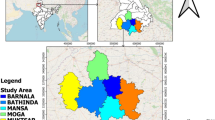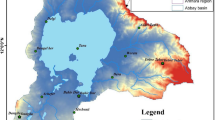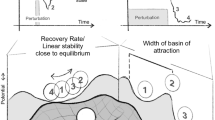Abstract
Vegetation plays a crucial role in providing organic matter and regulating energy exchange on the Earth's surface. This study investigates the changes in vegetation cover, temperature, and precipitation in northeastern Iran during 2001–2020. MODIS-NDVI time series data and climatic data from 11 synoptic stations were utilized. The nonparametric Mann–Kendall method was employed to detect trends in vegetation cover and climatic variables. Additionally, the correlation between climatic parameters and vegetation was examined. Trend analysis revealed significant increases/decreases in vegetation cover in 32%/26% of the region, respectively. The increasing trend in vegetation cover was predominantly observed in highlands, suggesting that a warmer climate has enhanced the living conditions for plants in these regions. The vegetation trend map indicates an expansion of vegetation cover in the northern and central parts of Iran during the past 20 years, whereas the southern and eastern portions experienced declines. The relationship between vegetation and elevation revealed that vegetation increased above 1,850 m and decreased below 850 m. Trend analysis showed no significant trend in precipitation data since the beginning of the twenty-first century, but an increasing trend in temperature was observed in 82% of the region’s area, excluding the western strip. Correlation coefficients between temperature, precipitation, and vegetation indicated that declining temperatures are the limiting factors for vegetation in the highlands, while in lowland areas, the decrease in precipitation significantly diminishes vegetation growth.











Similar content being viewed by others
Data availability
All MODIS-NDVI data used during this study are openly available from the NASA Earth Data Distributed Active Archive Center at: https://modis-land.gsfc.nasa.gov. Also, the climatic data are prepared from Iranian Meteorological Organization and are available from the corresponding author on reasonable request.
Notes
Digital Elevation Model.
References
Akbarzadeh, M., & Mirhaji, S. T. (2006). Vegetation changes under precipitation in Steppe rangelands Rudshur, Iranian. Journal of Range and Desert Reaserch, 13(3), 222–235.
Araghi, A., Mousavi Baygi, M., Adamowski, J., Malard, J., Nalley, D., & Hasheminia, S. M. (2015). Using wavelet transforms to estimate surface temperature trends and dominant periodicities in Iran based on gridded reanalysis data. Atmospheric Research, 155, 52–72.
Araghi, A., Adamowski, J., Martinez, C. J., & Olesen, J. E. (2019). Projections of future soil temperature in northeast Iran. Geoderma, 349, 11–24.
Azevedo, O., Parker, T. C., Siewert, M. B., & Subke, J. A. (2021). Predicting soil respiration from plant productivity (NDVI) in a sub-arctic tundra ecosystem. Remote Sensing, 2021(13), 2571.
Bindajam, A. A., Mallick, J., AlQadhi, S., Singh, C. K., & Hang, H. T. (2020). Impacts of vegetation and topography on land surface temperature variability over the semi-arid mountain cities of Saudi Arabia. Atmosphere, 11(7), 762.
Chen, T., Bao, A., Jiapaer, G., Guo, H., Zheng, G., Jiang, L., Chang, C., & Tuerhanjiang, L. (2019). Disentangling the relative impacts of climate change and human activities on arid and semiarid grasslands in Central Asia during 1982–2015. Science Total Environmental, 653, 1311–1325.
Dastigerdi, M., Nadi, M., Sarjaz, M. R., & Kiapasha, K. (2022). Vegetation trend analysis using NDVI time series of MODIS satellite in the northeast of Iran. Journal of Water and Soil Conservation, 29(1), 135–150.
Davis, C. J., & Hanna, E. G. (2020). Seasonal temperature and rainfall extremes 1911–2017 for Northern Australian population centres: Challenges for human activity. Regional Environmental Change, 20, 128.
De Jong, R., & De Bruin, S. (2012). Linear trends in seasonal vegetation time series and the modifiable temporal unit problem. Biogeosciences, 9, 71–77.
Doulabian, S., Golian, S., Toosi, A. S., & Murphy, C. (2021). Evaluating the effects of climate change on precipitation and temperature for Iran using RCP scenarios. Journal of Water and Climate Change, 12(1), 166–184.
Dye, D. G., & Tucker, C. J. (2003). Seasonality and trends of snow-cover, vegetation index, and temperature in Northern Eurasia. Geophysical Research Letters, 30, 1405.
Ebrahimi-khusfi, Z., Mirakbari, M., & Khosroshahi, M. (2020). Vegetation response to changes in temperature, rainfall, and dust in arid environments. Environmental Monitoring and Assessment, 192(11), 691.
Emamian, A., Rashki, A., Kaskaoutis, D. G., Gholami, A., Opp, C., & Middleton, N. (2021). Assessing vegetation restoration potential under different land uses and climatic classes in Northeast Iran. Ecological Indicators, 122, 107325.
Erasmi, S., Klinge, M., Dulamsuren, C., Schneider, F., & Hauck, M. (2021). Modelling the productivity of Siberian larch forests from Landsat NDVI time series in fragmented forest stands of the Mongolian forest-steppe. Environmental Monitoring and Assessment, 193, 1–18.
Fang, W., Huang, S. Z., Huang, Q., Huang, G. H., Wang, H., Leng, G. Y., Wang, L., & Guo, Y. (2019). Probabilistic assessment of remote sensing-based terrestrial vegetation vulnerability to drought stress of the Loess Plateau in China. Remote Sensing of Environment, 232, 111290.
Fensholt, R., Rasmussen, K., Nielsen, T. T., & Mbow, C. (2009). Evaluation of earth observation based global long term vegetation trends - intercomparing NDVI time series trend analysis consistency of Sahel from AVHRR GIMMS, terra MODIS and SPOT VGT data. Remote Sensing of Environment, 113(9), 1886–1898.
Guo, E. L., Wang, Y. F., Wang, C. L., Sun, Z. Y., Bao, Y. L., Naren, M., Buren, J., Bao, Y. H., & Li, H. (2021). NDVI indicates long-term dynamics of vegetation and its driving forces from climatic and anthropogenic factors in Mongolian Plateau. Remote Sensing, 13, 688.
Harpold, A. A., & Molotch, N. P. (2015). Sensitivity of soil water availability to changing snowmelt timing in the western US. Geophysical Research Letters, 42, 8011–8020.
Harris, I. P. D. J., Jones, P. D., Osborn, T. J., & Lister, D. H. (2014). Updated high-resolution grids of monthly climatic observations–the CRU TS3. 10 dataset. International journal of climatology, 34(3), 623–642.
Howden, S. M., Soussana, J.-F., Tubiello, F. N., Chhetri, N., Dunlop, M., & Meinke, H. (2007). Adapting agriculture to climate change. Proceedings of the National Academy of Sciences, 104(50), 19691–19696.
Huang, S., Tang, L., Hupy, J. P., Wang, Y., & Shao, G. (2021). A commentary review on the use of normalized difference vegetation index (NDVI) in the era of popular remote sensing. Journal of Forestry Research, 32, 1–6.
Jamali, S., Jönsson, P., Eklundh, L., Ardö, J., & Seaquist, J. (2015). Detecting changes in vegetation trends using time series segmentation. Remote Sensing of Environment, 156, 182–195.
Kendall, M. G. (1948). Rank correlation methods. Oxford University Press.
Khaledi, S., Keikhosravi, G., & Ahmadibarati, F. (2022). Investigation of the effect of land cover changes on the surface temperature of the earth using MODIS satellite images-case study: Northeast of Iran. Scientific-Research Quarterly of Geographical Data (SEPEHR), 31(123), 179–197.
Kiapasha, K., Darvishsefat, A., Julien, Y., Sobrino, J., Zargham, N., Attarod, P., & Schaepman, M. (2017a). Trends in phenological parameters and relationship between land surface phenology and climate data in the Hyrcanian Forests of Iran. IEEE Journal of Selected Topics in Applied Earth Observations and Remote Sensing, 10(11), 4961–4970.
Kiapasha, K., Darvishsefat, A. A., Zargham, N., Attarod, P., Nadi, M., & Schaepman, M. (2017b). Greening trend in the Hyrcanian forests using NOAA NADVI time series during 1981–2012. Forest and Wood Products, 70(3), 409–420.
Lamchin, M., Park, T., Lee, J. Y., & Lee, W. K. (2015). Monitoring of vegetation dynamics in the mongolia using MODIS NDVIs and their relationship to rainfall by natural zone. Journal of the Indian Society of Remote Sensing, 43(2), 325–337.
Li, J. X., Chen, Y. N., Xu, C. C., & Li, Z. (2019a). Evaluation and analysis of ecological security in arid areas of Central Asia based on the emergy ecological footprint (EEF) model. Journal of Cleaner Production, 235, 664–677.
Li, L., Zhang, Y., Wu, J., Li, S., Zhang, B., Zu, J., Zhang, H., Ding, M., & Paudel, B. (2019b). Increasing sensitivity of alpine grasslands to climate variability along an elevational gradient on the Qinghai-Tibet Plateau. Science of the Total Environment, 678, 21–29.
Liu, B. Y., Chen, J., Chen, J. G., & Zhang, W. W. (2018). Land cover change detection using multiple shape parameters of spectral and NDVI curves. Remote Sensing, 10, 1251.
Liu, Z., Chen, D., Liu, S., Feng, W., Lai, F., Li, H., & Zan, M. (2022). Research on vegetation cover changes in arid and semi-arid Region based on a Spatio-temporal fusion model. Forests, 13(12), 2066.
Luo, L., Ma, W., Zhuang, Y., Zhang, Y., Yi, S., Xu, J., & Zhang, Z. (2018). The impacts of climate change and human activities on alpine vegetation and permafrost in the Qinghai-Tibet Engineering Corridor. Ecological Indicators, 93, 24–35.
Ma, J., Xiao, X., Miao, R., Li, Y., Chen, B., Zhang, Y., & Zhao, B. (2019a). Trends and controls of terrestrial gross primary productivity of China during 2000–2016. Environmental Research Letters, 14, 084032.
Ma, X., Hongying, B., Chenhui, D., & Tao, W. (2019b). Sensitivity of vegetation on alpine and subalpine timberline in Qinling Mountains to temperature change. Forests, 10(12), 1105. https://doi.org/10.3390/f10121105
Malle, J. T., Mazzotti, G., Karger, D. N., & Jonas, T. (2023). Regionally optimized high resolution input datasets enhance the representation of snow cover and ecophysiological processes in CLM5. Egusphere, 2023, 1–38.
Mann, H. B. (1945). Nonparametric tests against trend. Econometrica, 13, 245–259. https://doi.org/10.2307/1907187
Na, R., Na, L., Du, H., He, H. S., Shan, Y., Zong, S., Huang, L., Yang, Y., & Wu, Z. (2021). Vegetation greenness variations and response to climate change in the arid and semi-arid transition zone of the Mongo-Lian Plateau during 1982–2015. Remote Sensing, 13(20), 4066. https://doi.org/10.3390/rs13204066
Naghinezhad, A., Akhlaghi, S. A., & Saeedi Mehrvarz, S. H. (2016). Investigating the relationship between ecological factors and vegetation cover in PALANGAN area, protected arear in Ardabil Province. Applied Ecology, 4(13), 33–48.
Palazzi, E., Filippi, L., & Von Hardenberg, J. (2017). Insights into elevation-dependent warming in the tibetan plateau-himalayas from cmip5 model simulations. Climate Dynamics, 48, 3991–4008.
Pan, N., Feng, X., Fu, B., Wang, S., Ji, F., & Pan, S. (2018). Increasing global vegetation browning hidden in overall vegetation greening: Insights from time-varying trends. Remote Sensing of Environment, 214, 59–67.
Pourbabaei, H., Salehi, A., Sadat Ebrahimi, S., & Khodaparast, F. (2021). The effects of altitude and the most important soil components on vegetation characteristics, Asalem Watershed. Iranian Journal of Forest, 13(3), 285–304.
Santo, F. E., Ramos, A. M., Lima, M. I. P., & Trigo, R. M. (2014). Seasonal changes in daily precipitation extremes in mainland Portugal from 1941 to 2007. Regional Environmental Change, 14, 1765–1788.
Tai, X., Epstein, H. E., & Li, B. (2020). Elevation and climate effects on vegetation greenness in an arid mountain-basin system of Central Asia. Remote Sensing, 12(10), 1665. https://doi.org/10.3390/rs12101665
Tan, Z., Tao, H., Jiang, J., & Zhang, Q. (2015). Influences of climate extremes on NDVI (normalized difference vegetation index) in the Poyang Lake Basin, China. Wetlands, 35(6), 1033–1042.
Wu, D., Wu, H., Zhao, X., Zhou, T., Tang, B., Zhao, W., & Jia, K. (2014). Evaluation of spatiotemporal variations of global fractional vegetation cover based on GIMMS NDVI Data from 1982 to 2011. Remote Sensing, 6(5), 4217–4239.
Wu, G., Liu, X., Chen, T., Xu, G., Wang, W., Zeng, X., & Zhang, X. (2015). Elevation-dependent variations of tree growth and intrinsic water-use efficiency in Schrenk spruce (Picea schrenkiana) in the Western Tianshan Mountains, China. Frontiers in Plant Science, 6, 309.
Xiao, J., & Moody, A. (2005). Geographical distribution of global greening trends and their climatic correlates: 1982–1998. International Journal of Remote Sensing, 26(11), 2371–2390.
Yang, J., Weisberg, P. J., & Bristow, N. A. (2012). Landsat remote sensing approaches for monitoring long-term tree cover dynamics in semi-arid woodlands: Comparison of vegetation indices and spectral mixture analysis. Remote Sensing of Environment, 119, 62–71.
Yang, Y., Tang, J., Xiong, Z., & Dong, X. (2017). Evaluation of high-resolution gridded precipitation data in arid and semiarid regions: Heihe River basin, Northwest China. Journal of Hydrometeorology, 18, 3075–3101.
Zhang, Y., Song, C., Band, L. E., Sun, G., & Li, J. (2017). Reanalysis of global terrestrial vegetation trends from MODIS products: Browning or greening?. Remote Sensing of Environment, 191, 145–155.
Zhou, L., Tian, Y., Myneni, R. B., Ciais, P., Saatchi, S., Liu, Y. Y., & Hwang, T. (2014). Widespread decline of congo rainforest greenness in the past decade. Nature, 509(7498), 86–90.
Zhou, S., Dong, Y., Julihaiti, A., Nie, T., Jiang, A., & An, S. (2022). Spatial variation in desert spring vegetation biomass, richness and their environmental controls in the Arid Region of Central Asia. Sustainability, 14(19), 12152.
Acknowledgements
The authors thank the Iranian Meteorological Organization for its cooperation and providing the climatic data.
Funding
No funding was obtained for this study.
Author information
Authors and Affiliations
Contributions
Conceptualization [Mehdi Nadi]; Methodology [Morteza Dastigerdi] and [Mehdi Nadi]; Soft-ware [Morteza Dastigerdi] and [Khadijeh Kiapasha]; Data curation [Morteza Dastigerdi]; Writing-Original draft preparation [Morteza Dastigerdi] and [Mehdi Nadi]; Investigation [Morteza Dastigerdi] and [Mehdi Nadi]; Validation [Morteza Dastigerdi]; Visualization [Khadijeh Kiapasha]; Writing-Reviewing and Editing [Morteza Dastigerdi], [Mehdi Nadi] and [Mahmoud Raeini Sarjaz]; Discussion [Mahmoud Raeini Sarjaz]; Supervision [Mehdi Nadi]. All authors read and approved the final manuscript.
Corresponding author
Ethics declarations
Competing interests
The authors declare no competing interests.
Additional information
Publisher's Note
Springer Nature remains neutral with regard to jurisdictional claims in published maps and institutional affiliations.
Rights and permissions
Springer Nature or its licensor (e.g. a society or other partner) holds exclusive rights to this article under a publishing agreement with the author(s) or other rightsholder(s); author self-archiving of the accepted manuscript version of this article is solely governed by the terms of such publishing agreement and applicable law.
About this article
Cite this article
Dastigerdi, M., Nadi, M., Sarjaz, M.R. et al. Trend analysis of MODIS NDVI time series and its relationship to temperature and precipitation in Northeastern of Iran. Environ Monit Assess 196, 346 (2024). https://doi.org/10.1007/s10661-024-12463-y
Received:
Accepted:
Published:
DOI: https://doi.org/10.1007/s10661-024-12463-y




